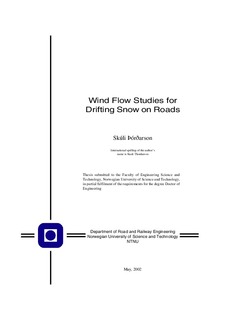| dc.contributor.author | Thordarson, Skuli | nb_NO |
| dc.date.accessioned | 2014-12-19T11:25:10Z | |
| dc.date.available | 2014-12-19T11:25:10Z | |
| dc.date.created | 2002-09-06 | nb_NO |
| dc.date.issued | 2002 | nb_NO |
| dc.identifier | 126337 | nb_NO |
| dc.identifier.isbn | 82-471-5481-1 | nb_NO |
| dc.identifier.uri | http://hdl.handle.net/11250/231332 | |
| dc.description.abstract | During strong winds, drifting snow causes problems on roads in many harsh winter climate countries. Increased snow-removal costs, reduced access and safety problems are typical results of excessive snowdrift sedimentation and bad visibility along many roads in the exposed regions.
The objective of the study is to enhance knowledge on drifting snow behaviour on roads and to develop design criteria for better road construction in mountainous areas and other areas where frequent snowfall and strong winds occur. The study is focused on road cuts, because road sections with terrain cuts are the most vulnerable both concerning visibility and snow depositing on the road. The study is mainly based on CFD (Computational Fluid Dynamics) and field measurements. Field studies were carried out in both Norway and Iceland, and include snow surveys, wind measurements and a visibility registration. A wind tunnel study on snow drifting around a model avalanche dam is also a part of the thesis.
Wind flow in road cuts was simulated and the resulting wind speed distribution and flow pattern were compared to snow surveys. On basis of this comparison and by considering experimental relationships between wind flow and snow drifting, new design principles were proposed.
An important result of the study is the distinction between wind flow and snow drifting in gently sloping road cuts and in steep road cuts, respectively. Wind and snow drifting in gently sloping cuts and on leeward facing hillsides can usually be described as a two-dimensional flow. On the other hand, steep road cuts generally create a vortex moving parallel the road, and the resulting flow pattern must be described in three dimensions.
Results for gently sloping road cuts suggest that in order to achieve a drift free road, it must be placed downwind of the equilibrium snowdrift surface. This implies that a considerable speed up in the wind has to occur over the road embankment to facilitate snow erosion from the road surface. A statistical method to predict equilibrium snowdrift surfaces by using terrain information only is proposed. The model is based on weighing terrain slopes, and creates a streamlined surface to imitate the shape of the equilibrium snowdrift surface.
For steep cuts, a design that features an expanded cut width at both ends of the cut was tested. The design increases the speed of the transverse vortex under the cut edge, and generates less turbulence than a straight cut, which is believed to have a positive effect on the visibility. The proposed design also moves the critical low speed areas away from the road, and should therefore result in less snow accumulation on the road.
It is concluded that plain wind flow simulations are a helpful tool to learn about snow drifting on roads, and can be used to test the quality of a proposed design. The suggested design principles for road cuts are promising for full scale testing. | nb_NO |
| dc.language | eng | nb_NO |
| dc.publisher | Fakultet for ingeniørvitenskap og teknologi | nb_NO |
| dc.relation.ispartofseries | Dr. ingeniøravhandling, 0809-103X; 2002:82 | nb_NO |
| dc.relation.haspart | Thordarson, S; Norem, H. Simulation of two-dimensional wind flow and snow drifting application for roads. Snow Engineering: Recent Advances and Development - Proceedings of the 4th International Conference on Snow Engineering. A.A Balkema, Rotterdam, 2000. | nb_NO |
| dc.relation.haspart | Thordarson, S. Snow sedimentation in gently sloping road cuts. . | nb_NO |
| dc.relation.haspart | Thordarson, S. Snow drifting on roads under steep sidehill cuts. . | nb_NO |
| dc.relation.haspart | Thordarson, S. Wind tunnel experiments and numerical simulations of snow drifting around an avalanche protecting dam. Environmental Fluid Mechanics. 2(4): 265-289, 2002. | nb_NO |
| dc.subject | Veibygging | no_NO |
| dc.subject | Snøforbygging | no_NO |
| dc.title | Wind flow studies for drifting snow on roads / | nb_NO |
| dc.type | Doctoral thesis | nb_NO |
| dc.source.pagenumber | 192 | nb_NO |
| dc.contributor.department | Norges teknisk-naturvitenskapelige universitet, Fakultet for ingeniørvitenskap og teknologi | nb_NO |
| dc.description.degree | dr.ing. | nb_NO |
| dc.description.degree | dr.ing. | en_GB |
